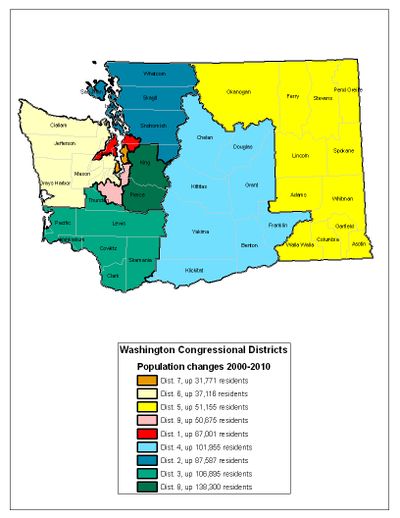All Washington congressional districts to shrink
Eastern Washington’s 5th has 51,155 too many

All congressional districts in Washington have too many people, tens of thousands too many. And in central Washington’s 4th District and two districts in the fast-growing I-5 corridor, they’ve got more than 100,000 too many.
Population figures released today by the U.S. Census Bureau confirm what state officials have long suspected: The state won’t just be adding its 10th congressional district this year. All the other nine will have to shrink.
All nine had almost the same population when they were drawn in 2001: 654,900 residents, give or take a few. The official headcount in the districts varied by no more than seven people.
That’s all changed. While the population of all nine has grown, the districts now have head counts ranging from 704,225 in downtown Seattle’s 7th District to 810,754 people in suburban King and Pierce counties’ 8th District.
Eastern Washington’s 5th Congressional District — which currently stretches from the Idaho border on the east to the Cascade Mountains where it borders Canada, and to the confluence of the Snake and Columbia rivers where it borders Oregon — has 723,609 people. That’s 51,155 too many for the average size a congressional district will be next year.
Central Washington’s 4th District — which now stretches from the east slope of the Cascades to Lake Chelan and the the Columbia River on its northern and southern extremities, meanders through the state’s farm country on the east — has grown almost twice as much. It has 774,409 people, or about 101,955 more than the average congressional district will have when redistricting is done.
Data from the Census Bureau shows the 5th District is the whitest, while the 4th is the most ethnically diverse. Almost 88 percent of the residents of the 5th listed their race as white. while nearly 2.5 percent listed themselves as Native American, 2 percent as Asian and slightly less than 1.5 percent as African-American; 6.3 percent listed themselves as Hispanic or Latino, which the Census Bureau counts separately from race.
In the 4th District, more than a third, 33.8 percent, listed themselves as Hispanic or Latino. Just under three-fourths of the residents listed themselves as white, and the African-American, Native American and Asian populations were all slightly lower than in the 5th, but nearly one in five listed themselves as “some other race”.
The growth in the 4th and 5th districts bolsters a theory by members of the redistricting commission earlier this year: For the first time in decades, at least one congressional district will have to straddle the Cascade Mountains and have voters from eastern and western Washington. Historic maps of the state’s congressional districts show that since at least the 1920s, two congressional districts were contained in Eastern and Central Washington.
The Washington state Redistricting Commission has begun work on redrawing congressional and legislative boundaries and has its next meeting March 29.